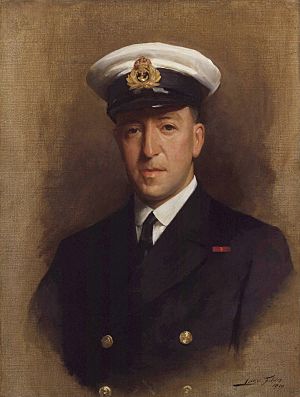Paul Fildes facts for kids
Quick facts for kids
Paul Fildes
|
|
|---|---|

Paul Fildes, as painted by his father, Luke Fildes in 1919
|
|
| Born |
Paul Gordon Fildes
10 February 1882 |
| Died | 5 February 1971 (aged 88) |
| Alma mater | Trinity College, Cambridge |
| Awards | Fellow of the Royal Society Royal Medal (1953) Copley Medal (1963) |
| Scientific career | |
| Institutions | University of Cambridge |
Sir Paul Gordon Fildes OBE FRS (born February 10, 1882 – died February 5, 1971) was a British scientist. He studied diseases (a pathologist) and tiny living things like bacteria (a microbiologist). During World War II, he worked at Porton Down to help develop ways to protect against biological weapons.
Contents
About Paul Fildes
Early Life and Education
Paul Fildes was born in Kensington, London. His father was a famous artist named Sir Luke Fildes. Paul went to Winchester School. Later, he studied surgery at Trinity College, Cambridge, where he earned a degree in medicine.
Career Highlights
During World War I, from 1915 to 1919, Fildes served in the Royal Naval Volunteer Reserve. He was a lieutenant-commander at the Royal Naval Hospital Haslar. In 1919, he was honored with the Officer of the Order of the British Empire award.
After the war, he worked as a bacteriologist at the London Hospital. In 1934, he moved to the Middlesex Hospital. That same year, he became a Fellow of the Royal Society, which is a big honor for scientists.
In 1940, he helped discover how certain medicines called sulphonamides worked. He was also part of the scientific team at the Medical Research Council from 1934 to 1949.
Work During World War II
In 1940, Paul Fildes was put in charge of a new group at Porton Down. This group was called the Biology Department, Porton (BDP). Their main job was to study how to defend against attacks using bacteria. He gathered a team of microbiologists to research biological weapons, like anthrax and botulinum toxin.
One important project was testing an anthrax bio-weapon. In 1942, his team did tests on Gruinard Island. Fildes also checked the bodies of sheep that had been exposed to anthrax. This helped them understand if the sheep died from the anthrax. This research led to the creation of the world's first working anthrax bomb in the summer of 1942. This work was focused on understanding these weapons for defense.
After the war, he went back to university. His deputy, David Henderson, took over the department. Henderson then built a new lab and created the Microbiological Research Department. Paul Fildes was knighted in 1946 for his important work.
Later Years and Awards
After World War II, Fildes worked at the Sir William Dunn School of Pathology in Oxford. He studied how certain viruses that infect bacteria, called bacteriophages, multiply.
In 1963, the Royal Society gave him the Copley Medal. This is one of the highest awards a scientist can receive.

